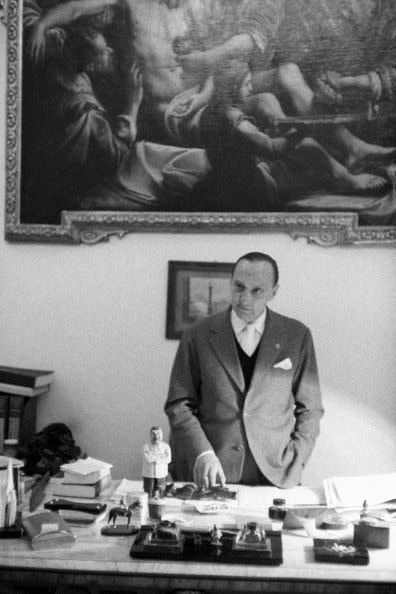It's a $40 Million Question: Was This 35-Carat Pink Diamond Stolen?

The Princie Diamond has been making headlines since Christie’s sold the 34.65 carat pink diamond at a New York auction in 2013 for a record-breaking $39.3 million. Soon after, an Italian family came forward claiming the diamond had been stolen by their stepsibling. And, just last week, a New York appellate court ruled in favor of the family, who are descendants of the Italian politician and businessman Renato Angiolillo, who purchased the stone from Van Cleef & Arpels in 1960. The case is now finally going to trial.
The Princie’s Long History
A pink diamond of this size, with such saturated color and quality, is a rare natural phenomenon, and only stones as remarkable as the Princie can be traced back centuries.
Experts say the Princie was discovered 300 years ago in India’s legendary ancient Golconda mines, which were once the source of many of the world’s most spectacular diamonds. The stone was first recorded in the 18th century as part of the Nizam of Hyderabad’s treasure chest of jewels, and it passed through generations of Indian rulers.
While having such an illustrious history adds to its value, it also makes it especially hard to conceal or sell such a stone without detection. Its whereabouts were unknown for decades until it appeared at a Sotheby’s auction in 1960, where it sold as “property of a gentleman” to an unknown buyer.

Later that year, Angiolillo, a wealthy politician and owner of one of Italy’s largest newspapers, Il Tempo, purchased the pink diamond from Van Cleef & Arpels. That same year he married his second wife, Maria Girani Angiolillo, and upon Angiolillo’s death in 1973, she retained custody of the stone (along with other jewels).
The Italian Connection
However, under Italian law, a person’s possessions are passed on to their children unless otherwise defined in their will. Hence after Maria's death in 2009, her late husband’s descendants, who reportedly had a good rapport with their stepmother, requested the gems be returned. But her son (and their stepbrother) Marco Oreste Bianchi Milella, insisted the stone, along with other valuable jewels, had just simply disappeared. The Angiolillo family filed a police report. They didn’t hear about the diamond again until it came up for sale at Christie’s New York four years later.
During an investigation, it was revealed that Milella had in fact sold the diamond to Swiss gem dealer David Gol for $20 million, who then consigned the stone to Christie’s in 2013. According to records, Milella claimed he inherited the diamond from his mother, who, he says, got the stone as a gift from her husband. Now it's up to the courts to decide who was the rightful owner of the stone when it was sold to Gol. There's a problem, though: the laws in Italy and in the United States, where the stone was sold, differ with respect to estates. Once Angiolillo’s family heard of the impending Christie’s sale, they alerted the auction house that the diamond was likely their stolen stone. But Christie's believed that Gol, the consignor, had the legal rights to it.
“This matter stems from a long-standing and highly contentious inheritance dispute among the members of an Italian family, who claim to be heirs of a past owner of the pink diamond,” said a Christie’s spokesperson following the appellate decision on last week. “While Christie’s is disappointed by the appellate court’s decision, we continue to believe that the evidence at trial will demonstrate that Christie’s consignor had the right to sells the diamond at issue, and that Christie’s acted in complete good faith in doing so in April 2013.” (Christie’s is a defendant in the case along with David Gol, his brother, and their companies.)
Big ticket diamonds and jewels are often a contentious issue in estates, divorces, and family feuds because they are small, valuable, and sentimental (and sometimes suspiciously misplaced). Those that are as rare and unusual as the Princie further complicate matters.
Estate Drama
“If there is anything that can be learned from the Princie court case it's that, even amongst spouses and family members, valuable and portable gifts of this nature need to be accompanied by deeds or wills,” says Lee Siegelson, a third generation New York jeweler who handles exceptional gems and period pieces. “The last legacy someone wants to leave their family is a court case.”
“Jewelry is the most portable form of wealth, and there are countless thrilling tales of Russian nobles smuggling their jewelry into Europe sewn into the seams of their clothing during the revolution,” says Siegelson. “Less thrilling and rather tedious, however, are tales of family discord due to obscure ‘gifts’ or inheritances.”

Today, the Princie Diamond is in the hands of the Qatari royal family, who paid the record-breaking sum at the 2013 Christie’s auction. But its fate is now in the hands of the courts. The trial was originally postponed last fall, when the state’s appellate division agreed hear an appeal filed by the defendants, but the court’s July 9 announcement that the trial can proceed means the saga continues.
For their part, the Angiolillo family wants the gem returned to them—if not, they'll take compensation. But whatever the outcome, one thing is clear: the Princie Diamond will surely go down as one of the most scandalous jewels in history.
You Might Also Like

